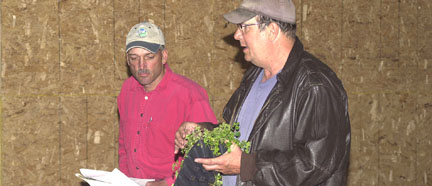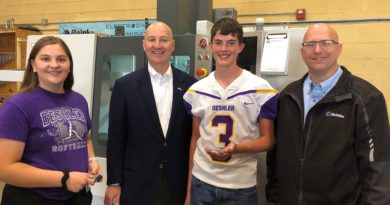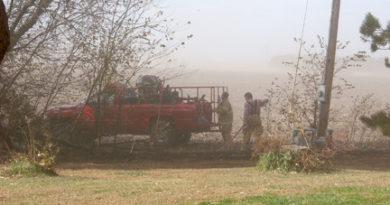Local know-how enhances proposed cooperative

If you don’t know him, you’ve probably seen him selling his vegetables in front of Central Market through the summers, and if you compete in the open class agriculture division at the county fair, chances are pretty good you’ve gone up against his products. Mark
Hintz is a local grower whose fresh vegetables are available for purchase out of the back of his pickup. Seasonal items such as broccoli, tomatoes, sweet corn, potatoes, melons, and cabbage line the pickup bed as he shares his wares.
The Hebron native and father of two who lives and farms with his wife Julie just east of town, has gardening in his blood. It comes naturally to him and although no one has probably ever asked him, his statements lead one to believe he can’t imagine living any other way.
“We have five to seven acres of sweet corn, melons and other vegetables that we sell,” he said during a recent workshop. “And we’re in the process of putting up a 30 x 96 high tunnel greenhouse for next year.”
The workshop, the first in a series of free trainings on basic gardening and growing for market, was held in Hintz’s barn. The Center for Rural Affairs in conjunction with Harold Stone, Davenport, hope to advance a local food system cooperative among surrounding counties through the series of workshops. Hintz and Stone led the first.
“Produce offered to us in rural grocery stores is significantly less quality than in urban grocery stores which doesn’t make sense to me,” Stone said. “Rural areas are generally agricultural, so how can the choices for fresh fruits and vegetables be less quality?”
He also sees the money paid for fresh food items in rural grocery stores as being sucked out of the local economies in that it goes back to growers in places like California and Texas. “We’re relying more on an institution that doesn’t include us anymore,” he stated, “and I think we can turn that around, from the ground up.”
Planting the Seed
Mark Hintz used to start his own seeds, has become quite an expert at it really, but as his garden has grown, so has his economic outreach. “I don’t start my seeds anymore, I have Karen (Mierau) do it,” he says. “She is the owner of Countrylane Greenhouse and she starts my cabbage, broccoli, tomatoes, egg plants and peppers.” Hintz jokes that he lets her do the work he used to do, but in all seriousness, he turns to the greenhouse as a means of supporting rural business.
Hintz said to start seeds, a gardener needs to study the subject; know what items are needed such as trays, lighting, fertilizer, and soil. “There are starter kits if you want,” he said while demonstrating the steps to planting a seed, “and pre-mixed potting soils containing the proper ingredients, plus grow lights that replicate the sun.” But gardeners can get as basic as they want by mixing their own soil or rigging up their own light and heat. “I’ve used an electric blanket for heat,” he said. “They’re cheaper than the heating pads specifically designed for seedlings and work just fine.”
Seeds are usually started at the end of February or beginning of March for this area, he added.
The Great Outdoors
Transplanting seedlings to the great outdoors shouldn’t happen until mid-May, Hintz says to ward off any chance of a freeze. But this year has been a weird one for gardeners. The unusual temperate clime has allowed gardeners to get their hands in the dirt sooner, and while there may be a chance the air temperature could dive to 32 degrees overnight, the University of Nebraksa-Lincoln School of Natural Resources says the frost-free planting date for this area is now April 24, instead of May 10.
“Under normal conditions,” Hintz says, “you should wait until Mother’s Day.”
Some root vegetables such as potatoes can go in as early as Good Friday, but generally anything that grows above the ground should be held off.
For the garden bed, Hintz attributes success to the three “Ls”…location, location, location. “Full sun,” he says. “Make sure your garden gets full sun, and whatever you do, don’t put your garden anywhere near a black walnut tree.”
Black walnut trees secrete a substance called juglone that inhibits the growth of other plants near them. Particularly toxic, juglone affects plants growing under the tree or within the sphere of its root system. Even walnut hulls, or rain leaching juglone from the leaves and branches to the ground below is toxic.
Hintz recommends checking the soil for proper nitrogen, potassium and phosphorous before planting. Seed dealers in the area will check soil samples for anyone, he said. And make sure the soil is a sandy loam, he added, because the roots need to spread out.
Grow, Baby, Grow
“Transplant your seedlings into the ground using the proper spacing,” he explained at the workshop stating that he plants his tomatoes 18 inches apart so the foliage is dense enough to stop sun scald on the fruit.
And while some gardeners see nothing wrong with pruning, Mark has an aversion to it. Why pick off a perfectly good bloom or chop the top off of a perfectly healthy plant, he asks, and says he just can’t do it. “I can’t help but think it hurts the plant,” he smiles and adds more seriously, “I think chopping off the top opens the plant to problems, makes it more susceptible to disease.”
John Green, a member of WWOOF (World Wide Opportunities on Organic Farms) who was also present at the workshop, said inter-planting crops is an ideal way to save space in the garden. For example, planting short season items like radishes in between long season crops like corn allows gardeners more growing opportunities and yields per bed. Trellis gardening for climbing plants such as melons also gives a more uniform fruit as well as saves space.
Who Invited You?
And finally, while gardeners spend hours studying, mixing, preparing and creating the ideal growing conditions for their new plants, uninvited pests tend to nose their way in. Floating on the breeze, dropped by high flying birds, carried in on busy insects, weed seeds quickly take root in the favorable soil seemingly created just for them.
“I use row cover to control the weeds,” Hintz explains, which is a paper mulch he can till into the ground after harvest. “Other mulches can come from straw and tree leaves. Just don’t use grass clippings. We tend to put chemicals on our lawns, so I don’t recommend putting the clippings in the garden. Chemicals that don’t hurt grass may be too strong for vegetables.”
Hintz also recommends tilling leaves into the ground before winter to give them a chance to break down into the soil before planting season. While laying them on top of the ground is good for weed control, they’ll still just be laying there in the spring if nothing is done, he said.
The Power of Education
While the workshops are extensive in nature, rendering finite details in growing fruits and vegetables, Stone is adamant about keeping the growing cooperative local. Utilizing area talent, such as Hintz’s knowledge and leadership as a local grower, is one of the ways Stone intends to keep his concept local.
Upcoming workshops featuring area talent throughout the growing season will detail selling at farmer’s markets (May 16); chemical free growing practices (June 20); garden care (July 18); marketing (Aug. 15); and harvest (Sep. 19).


